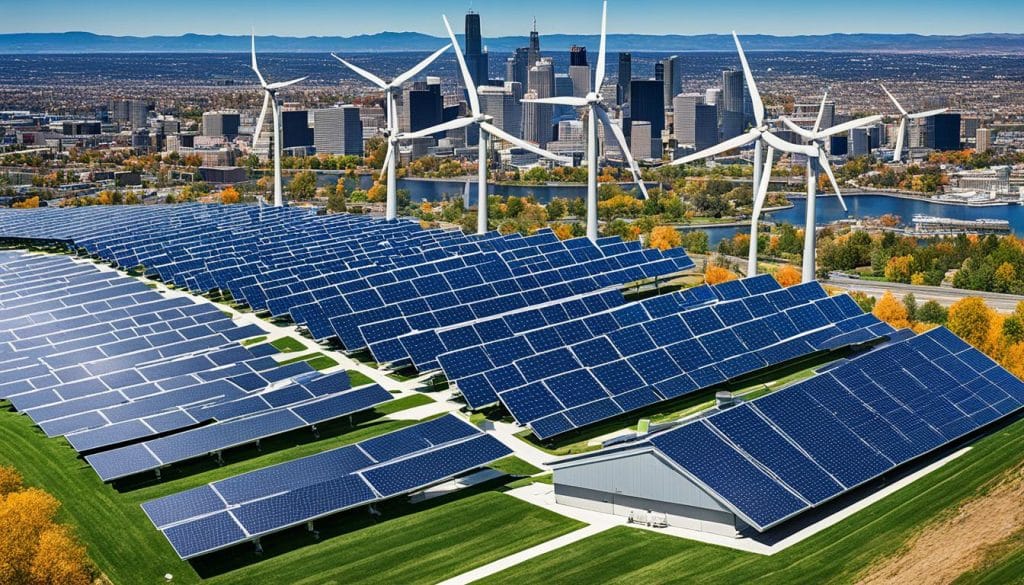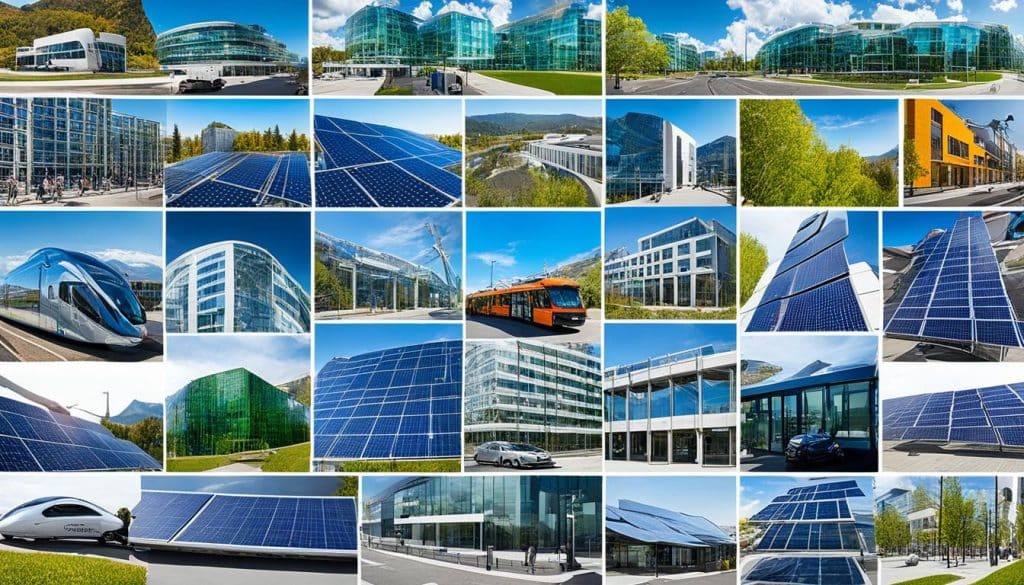The United States is facing a big challenge with its energy use. It’s too high and has big effects on the economy and the planet. The USA wants to cut down on energy use with a detailed plan. This includes government reports and data from top energy agencies showing we need to act fast.
This plan is not just about using less energy. It’s also about making a future that’s good for the planet. By using less energy, we can make a big difference for the better.
Key Takeaways
- The USA is prioritising reductions in energy consumption for a sustainable future.
- Excessive energy use has detrimental effects on both the economy and the environment.
- Government reports emphasise the urgent need for action on energy efficiency.
- A multifaceted approach will be essential for achieving energy reduction goals.
- Efforts towards sustainability will benefit future generations.
The Energy Consumption Challenge in the USA
The USA faces big challenges with its energy use. The country’s population and economic activities keep growing, making more energy needed. It’s vital to understand these trends to tackle the issues with energy use.
Current Consumption Trends
There’s a big move towards using more fossil fuels, which is bad for the planet. Here are some key points about energy use in the USA:
- Fossil fuels make up over 80% of energy use, with coal, oil, and natural gas leading the way.
- Energy use goes up a lot during extreme weather, especially when it’s very hot or cold.
- Cities use most of the energy, with urban areas taking nearly two-thirds of what’s produced.
This high energy use is bad for the environment, leading to more greenhouse gases. The Environmental Protection Agency (EPA) says the USA is a big emitter. This shows we need new ways to reduce our energy use.
Here’s a table that shows how much energy comes from different sources:
| Energy Source | Percentage of Total Consumption | Impact on Environment |
|---|---|---|
| Natural Gas | 36% | Moderate greenhouse gas emissions |
| Coal | 12% | High greenhouse gas emissions |
| Oil | 37% | Significant greenhouse gas emissions |
| Renewables | 15% | Minimal environmental impact |
Understanding these trends is key to making policies that help reduce our environmental impact. We need to find ways to meet our energy needs without harming the planet.
Implementing Policy Changes for Energy Efficiency
In the USA, there’s a big push to make energy use more efficient. This is happening through new laws. These laws show we need to use less energy and protect the environment. They set new standards for different areas to help us live sustainably in the future.
Legislative Efforts
There are key laws like the Energy Policy Act leading the way. The Biden administration is also pushing for better building codes and appliance standards. These changes aim to drive innovation and get more people using energy-saving tech.
Some key parts of these laws include:
- Stronger energy-saving rules for homes and businesses.
- Money for utilities to start energy-saving projects.
- Money for research into new energy technologies.
- More support for saving energy in states.
These steps are part of a big plan to make the USA’s energy use better. They bring together government and green groups to push for sustainable actions nationwide.
| Policy | Description | Impact |
|---|---|---|
| Energy Policy Act | A comprehensive law aimed at improving energy efficiency in various sectors. | Expected reduction in overall energy consumption. |
| Biden Administration Initiatives | Focus on upgrading building codes and appliance standards to enhance efficiency. | Encouragement of innovations in energy-saving technologies. |
| State Energy Efficiency Programmes | State-level initiatives supporting local energy efficiency improvements. | Boosted state economies and reduction in energy bills for consumers. |
The Role of Renewable Energy Sources

Renewable energy is key to the USA’s plan to cut down on energy use. Moving to solar, wind, and hydroelectric power is a big step away from fossil fuels. This change is happening thanks to more investments, new tech, and government support for green practices.
Transitioning to Renewable Energy
The USA has seen a big jump in spending on renewable energy tech lately. The National Renewable Energy Laboratory (NREL) says solar and wind power installations have gone up a lot. These sources are cleaner, help the country be more independent, and make energy more secure.
Government help, like tax credits and grants, has got the private sector involved in renewable projects. Using smart tech in energy management makes things more efficient. This helps renewable energy fit better into the current energy system.
Here’s a table showing how renewable energy capacity in the USA has grown over the years:
| Year | Solar Capacity (GW) | Wind Capacity (GW) | Hydroelectric Capacity (GW) |
|---|---|---|---|
| 2018 | 62.9 | 96.7 | 81.6 |
| 2019 | 70.0 | 100.0 | 81.2 |
| 2020 | 83.4 | 107.4 | 80.3 |
| 2021 | 98.1 | 113.1 | 78.3 |
| 2022 | 116.4 | 120.0 | 76.9 |
By focusing on renewable energy, the USA is moving towards a greener energy future. This shift is crucial for less environmental harm and a strong energy system.
Technological Innovations Driving Energy Reduction
Advances in energy technology are key to solving energy use challenges. Smart grids and energy management systems are vital for better energy efficiency. They make energy distribution more reliable and help use energy wisely.
Smart Grids and Energy Management Systems
Smart grids are a big step up in energy distribution and monitoring. They use advanced tech to let energy flow both ways between utilities and users. This means real-time info exchange for better energy management, letting users check and change their use habits.
Energy management systems work with smart grids to look at energy use data. They help businesses and people find ways to use less energy. Together, smart grids and energy management systems make a full plan to cut energy use, using data to make smart choices.
Here’s a table showing the main points of smart grids and old energy systems:
| Feature | Smart Grids | Traditional Energy Systems |
|---|---|---|
| Data Management | Real-time data analytics | Minimal data collection |
| Consumer Interaction | Two-way communication | One-way communication |
| Infrastructure | Decentralised architecture | Centralised architecture |
| Energy Source Integration | Seamless integration of renewables | Limited integration capabilities |
| Reliability | Enhanced reliability through real-time monitoring | Reliability dependent on manual oversight |
Using smart grids and energy management systems, companies can cut energy use and make energy supply more efficient and reliable. As these techs get better, they’ll have a bigger effect on how we use energy.
Strategic Partnerships with the Private Sector
Public-private partnerships are key to boosting energy efficiency in the USA. They bring together government and private sector innovation to improve energy use and sustainable practices. This teamwork helps tackle the challenges of making energy use more efficient.
Collaboration for Energy Efficiency
These partnerships have led to big wins in energy-saving tech. The Department of Energy shares stories of how these alliances encourage investments in green solutions. This benefits the economy and the planet. For example, working with energy service companies (ESCOs) leads to projects that cut energy use in buildings and homes.
Here are some examples of how public-private partnerships are making a difference in energy efficiency:
| Partnership | Focus Area | Results |
|---|---|---|
| Energy Star | Appliance Efficiency | Reduced energy consumption by over 100 billion kWh annually |
| Better Buildings Initiative | Building Efficiency | Saved $1.3 billion in energy costs for the participating organisations |
| Green Button Initiative | Consumer Engagement | Improved energy data access for over 10 million consumers |
These examples show how public-private partnerships can make a big impact on energy efficiency. By encouraging innovation and sharing knowledge, the USA can keep leading the way in reducing energy use.
The USA is working on reducing its huge energy use
The United States is focusing on cutting down its energy use across different areas. Government groups and state agencies are starting many projects to save a lot of energy. These projects aim to lower energy use and make the environment better.
One big part of these efforts is making government buildings more energy-efficient. This means putting in better insulation, updating heating and cooling, and using less energy lights. These changes have cut down costs and helped save energy.
There’s also a big push for more renewable energy projects. Wind farms, solar panels, and hydroelectric plants are becoming key parts of the country’s energy mix. These efforts show a strong commitment to using less fossil fuel, cleaning the environment, and finding sustainable energy for the future.
- Government building retrofitting projects
- Investment in solar energy developments
- Expansion of wind energy facilities
- Innovative research into energy storage solutions
Federal Initiatives to Promote Energy Conservation
The USA’s federal energy initiatives are key to boosting energy saving efforts. Many major programmes have been set up to encourage sustainable habits in both consumers and industries. These efforts not only guide people but also offer money support for energy-saving projects nationwide.
Major Federal Programmes
The Energy Star programme is a big help, spotlighting energy-efficient products. This lets consumers make better choices for saving energy. The government backs these efforts with grants for energy-saving projects.
| Programme | Description | Funding Available |
|---|---|---|
| Energy Star | A programme promoting energy-efficient appliances and practices. | Incentives based on product efficiency. |
| Weatherization Assistance Programme | Helps low-income families improve energy efficiency in their homes. | Grants to cover weatherisation costs. |
| Renewable Energy Deployment Initiative | Supports the integration of renewable energy sources into communities. | Funding for project implementation. |
These federal energy initiatives are crucial for improving energy saving in the USA. They aim at both environmental and economic goals. By offering money support and advice, the government encourages more people to use energy wisely.
State-Level Programs and Their Impact
State energy programmes are key to improving energy efficiency in the USA. They show how different states use their own methods to cut down energy use. California’s Title 24 building standards are a great example. They show how strict rules can change how buildings use energy.
Successful State Initiatives
States have come up with new ways to make energy use better. Here are some top examples:
- California: Title 24 encourages buildings to be more efficient, saving a lot of energy in homes and businesses.
- Massachusetts: Its energy plan is known nationwide for being thorough, which has greatly reduced electricity use.
- New York: The Clean Energy Standard aims for 50% renewable energy by 2030, making a big change in energy use.
These state programmes are checked often to see how well they work and if they need to change. The data shows that what works in one place can work elsewhere, helping the whole country use energy better.
Public Awareness Campaigns on Energy Usage

Public awareness campaigns are key in teaching people about energy use and how to save it. Campaigns like “Save Energy, Save Money” show the importance of cutting down on energy waste at home and in businesses. They tell people how their actions affect energy use and push for changes towards being more eco-friendly.
Educating Consumers
Teaching people about saving energy is vital. Non-profit groups say more people now understand the need for energy efficiency thanks to education. Surveys show that those who have seen these campaigns want to use less energy in their everyday life.
What makes teaching people effective includes:
- Informative workshops and seminars
- Accessible online resources
- Working with local communities
- Incentives for using energy-saving tech
These efforts have really made a difference. Studies show big cuts in energy use by those who took part. This proves the worth of teaching the public about saving energy.
| Campaign Name | Main Focus | Year Introduced | Estimated Impact |
|---|---|---|---|
| Save Energy, Save Money | Household energy efficiency | 2015 | 20% reduction in average home energy use |
| Green Your Routine | Commercial energy practices | 2018 | 15% decrease in participating businesses’ energy consumption |
| Energy Savers Challenge | Community engagement | 2020 | 10% reduction in collective community energy use |
Energy Audits and Their Importance
Energy audits are key to improving energy efficiency in the USA. They check how much energy buildings and facilities use. This helps find ways to use less energy and save money. More and more, both public and private groups are doing these audits to use resources better and fight high energy costs.
Conducting Effective Audits
Starting an energy audit involves several important steps:
- First, we talk to understand what the audit aims to achieve.
- Then, we collect data like energy bills, lists of equipment, and building plans.
- We visit the site to see how energy is being used and find where it’s wasted.
- We use special tools and software to measure how well things are working.
- Finally, we put all the info into a detailed report that shows how to improve.
Energy audits do more than just spot where energy is wasted. They give clear advice on how to use energy better and invest in new, efficient technologies. Taking action on these suggestions is key to using energy in a sustainable way over time.
Experts say that following the advice from energy audits can cut energy costs by up to 30%. Many sectors, like businesses and industries, have changed a lot thanks to these audits. Here’s a table showing the savings in different industries:
| Industry | Average Savings (%) | Common Recommendations |
|---|---|---|
| Commercial Buildings | 20-25% | LED lighting upgrades, HVAC optimisation |
| Manufacturing | 15-30% | Equipment retrofits, process streamlining |
| Healthcare | 10-20% | Energy-efficient appliances, insulation improvements |
In conclusion, using energy audits is crucial for the USA’s efforts to use energy better. These audits not only show where things are not efficient. They also help companies adopt sustainable practices. This leads to both economic and environmental benefits over time.
Challenges in Achieving Energy Reduction Goals
The journey to cut energy use in the USA faces many challenges. These include both technical and social issues. Knowing these challenges helps us understand what we need to do to improve.
Overcoming Obstacles
Some big hurdles stand in the way:
- Funding Shortages: We need enough money for new tech and infrastructure.
- Consumer Resistance: People are slow to change their ways or buy new, efficient appliances.
- Regulatory Hurdles: Too many rules can make it hard for companies to get things done.
Studies show that tackling these issues with a strong plan can help the USA meet its energy goals. Working together is key. We need government, businesses, and consumers to join forces for a greener future.
Best Practices from Other Countries

Looking at how other countries manage their energy can teach us a lot. Germany and Denmark have made big strides in cutting down energy use. They have set up systems that could be a model for the USA to follow.
Global Perspectives on Energy Efficiency
Studying how different countries handle energy efficiency shows us several key strategies:
- Germany: Sets high energy efficiency standards, focuses on renewable energy, and uses technology to help.
- Denmark: Puts a lot into wind energy and works with both public and private sectors to improve energy use.
- Japan: Has advanced energy management in commercial buildings, which cuts down energy waste a lot.
Research from global energy meetings shares success stories and practical tips. Using these global best practices could help the USA move faster towards sustainable energy.
| Country | Key Strategies | Impact on Energy Efficiency |
|---|---|---|
| Germany | Stricter standards, renewable integration | 20% reduction in energy consumption since implementation |
| Denmark | Wind energy investments, public-private partnerships | Achieved 47% of energy from renewables in 2019 |
| Japan | Smart energy management systems | 30% decrease in energy usage in large buildings |
Future Projections for Energy Consumption in the USA
The future of energy use in the USA will be influenced by population growth, urbanisation, and tech progress. These factors will lead to a big increase in energy needs. With more people, there will be more homes and businesses, which means more energy is needed.
Urbanisation will also make energy use go up. More people in cities means a bigger need for efficient energy solutions. New tech, especially in renewable energy, will help meet this demand and reduce harm to the environment.
The International Energy Agency predicts a shift to sustainable energy use. This aims to balance energy needs with caring for the planet. Such projections highlight the need for a detailed plan for energy use, focusing on efficiency and sustainability.
| Year | Population (millions) | Projected Energy Consumption (TWh) | Renewable Energy Share (%) |
|---|---|---|---|
| 2025 | 335 | 4,200 | 25 |
| 2030 | 350 | 4,600 | 30 |
| 2035 | 365 | 5,000 | 35 |
| 2040 | 380 | 5,500 | 40 |
These figures show how energy use in the USA is changing. The country aims for a sustainable energy future. These projections will guide important decisions on energy policies and investments in renewable tech.
Benefits of Reducing Energy Consumption
Efforts to use energy more efficiently are vital and bring many benefits. They help the environment and save money. By using less energy, we can fight climate change and make our planet healthier for the future.
Environmental and Economic Gains
Reducing energy use saves money for businesses and homes. It means lower bills and more money for growth. This helps the economy and makes things more productive.
It also helps the environment by cutting down on harmful gases and pollution. Using less energy means cleaner air and better health for everyone. By doing this, we’re not just saving money now, but also taking care of the earth for the future.
















